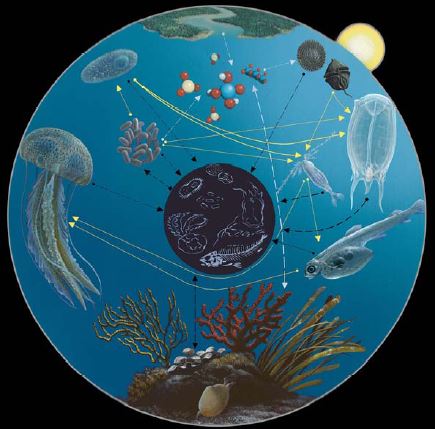1.4 The grand picture
Marine ecosystems functioning, thus, takes place through three main pelagic pathways: the phytoplankton > herbivorous crustacean zooplankton > carnivorous zooplankton > fish pathway, the phytoplankton > herbivorous crustacean zooplankton > carnivorous gelatinous zooplankton pathway, and the phytoplankton > herbivorous gelatinous zooplankton pathway (Fig. 7).
These pathways are not mutually exclusive, but one can prevail over the others. Usually, the first one (ending up with fish) prevails and determines what we consider as a “normal” situation (Fig. 4). The other two pathways, one ending up with carnivorous gelatinous zooplankton (Fig. 5) and the other with herbivorous gelatinous zooplankton (Fig. 6), from time to time can go through episodic success that, normally, cannot disrupt the prevailing pathway, ending up with fish. These blooms might even enhance the diversity in the nekton, as hypothesized above. The scientific literature is replenished of records of “anomalous” blooms of gelatinous plankton that, traditionally, have been considered as freaks in the functioning of marine systems. As a matter of fact, they are not freaks, they are part of the manifold possibilities in which marine ecosystems work.
The evolutionary lineages interacting in these systems coexist since millions of years and can cope with each other.

Figure 7. The three main pathways determining marine ecosystem functioning (art by A. Gennari, graphics by F. Tresca).